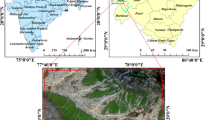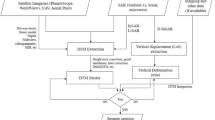Topographic index is an important attribute of digital elevation model (DEM) which indicates soil saturation. It is used for estimation of run-off, soil moisture, depth of ground water and hydrological simulation. Topographic index is derived from DEMs; hence the accuracy of DEM influences its computation. Commonly the raster based grid DEM is widely used to simulate hydrological model parameter, and accuracy varies with respect to DEM grid size and morphological characteristics of terrain. In this study topographic index is evaluated in terms of DEM grid size and terrain roughness. The study was carried out on four small watersheds, having different roughness characteristics, located over the Himalayan terrain. Topographic index surface is derived for each watershed from different grid spacing DEM (10–150 m), analysed and validated. It is found that DEM grid spacing affects the topographic index. The surface representation is smooth in the coarse grid spacing and the pattern of topographic index changes with grid spacing. The spatial autocorrelation of topographic index surface reduces when calculated from larger spacing DEM. The mean of the topographic index surface increases and standard deviation decreases with the increase of grid spacing and the effect is more pronounced in the rough terrain. Accuracy of the topographic index is also evaluated with respect to grid spacing and terrain roughness by comparing the topographic index surface with respect to reference data (10 m grid spacing topographic index surface). The RMSE and mean error of topographic index surface increases in larger grid spacing and the effect is more in rugged terrain.


















Similar content being viewed by others
References
Baltsavias E, Kocaman S and Wolff K 2007 Geometric and radiometric investigations of Cartosat-1 data; In: ISPRS Hannover Workshop 2007, High Resolution Earth Imaging for Geospatial Information, Hannover, Germany, May 29–June 1.
Beven K and Kirkby M J 1979 A physically based variable contributing area model of basin hydrology; Hydrol. Sci. Bull. 24 43–69.
Brasington J and Richards K 1998 Interactions between model predictions, parameters and DTM scales for topmodel; Comput. Geosci. 24(4) 299–314.
Burrough P A, Wilson J P and Gaans P F M V 2001 Fuzzy k-means classification of topo-climatic data as an aid to forest mapping in the Greater Yellowstone Area, USA; Landscape Ecol. 16 523–546.
Cai X and Wang D 2006 Spatial autocorrelation of topographic index in catchments; J. Hydrol. 328 581–591.
Chappell N A, Vongtanaboon S, Jiang Y and Tangtham N 2006 Return-flow prediction and buffer designation in two rainforest headwaters; Forest Ecol. Manag. 224 131–146.
Dale M R T and Fortin M J 2002 Spacial autocorrelation and statistical tests in ecology; Ecoscience 9(2) 162–167.
Demoulin A, Bovy B, Rixhon G and Cornet Y 2007 An automated method to extract fluvial terraces from digital elevation models: The Vesdre valley, a case study in eastern Belgium; Geomorphology 91 51–64.
Dragut L and Eisank C 2011 Object representations at multiple scales from digital elevation models; Geomorphology 129 183–189.
Gómez-Plaza A, Martínez-Mena M, Albaladejo J and Castillo V M 2001 Factors regulating spatial distribution of soil water content in small semiarid catchments; J. Hydrol. 253 211–226.
Goodchild M F 1986 Spatial Autocorrelation: Concepts and Techniques in Modern Geography; Geo Books, Norwich, UK.
Grayson R B, Western A W, Chiew F H S and Blöschl G 1997 Preferred states in spatial soil moisture patterns: Local and nonlocal controls; Water Resour. Res. 33(12) 2897–2908.
Grimaldi S, Nardi F, Benedetto F, Istanbulluoglu E and Bras R L 2007 A physically-based method for removing pits in digital elevation models; Adv. Water Resour. 30 2151–2158.
Guth P L 1995 Slope and aspect calculations on gridded digital elevation models: Examples from a geomorphometric toolbox for personal computers; Zeitschrift Geomorph N.F. Suppl.-Bd. 101 31–52.
Hjerdt K N, McDonnell J J, Seibert J and Rodhe A 2004 A new topographic index to quantify downslope controls on local drainage; Water Resour. Res. 40(5) W05602.
Huang B and Jiang B 2002 AVTOP: A full integration of TOPMODEL into GIS; Environ. Modelling & Software 17 261–268.
Irvin B J, Ventura S J and Slater B K 1997 Fuzzy and isodata classification of landform elements from digital terrain data in Pleasant Valley, Wisconsin; Geoderma 77(2–4) 137–154.
Jenson S K and Domingue J O 1988 Extraction topographic structure from digital elevation data for geographic information system analysis; Photogram. Eng. Rem. Sens. 54(11) 1593–1600.
Joshi P K, Yadav K and Sinha V S P 2011 Assessing impact of forest landscape dynamics on migratory corridors: A case study of two protected areas in Himalayan foothills; Biodiversity and Conservation 20(14) 3393–3411.
Kakembo V, Rowntree K and Palmer A R 2007 Topographic controls on the invasion of Pteronia incana (Blue bush) onto hillslopes in Ngqushwa (formerly Peddie) district, Eastern Cape, South Africa; Catena 70 185–199.
Kennelly P J 2008 Terrain maps displaying hill-shading with curvature; Geomorphology 102 567–577.
Kumar P, Verdin K L and Greenlee S K 2000 Basin level statistical properties of topographic index for North America; Adv. Water Resour. 23 571–578.
Mackey B G 1994 Predicting the potential distribution of rain-forset structural characteristics; J. Vegetation Sci. 5(1) 43–54.
Merot P, Squividant H, Aurousseau P, Hefting M, Burt T, Maitre V, Kruk M, Butturini A, Thenail C and Viaud V 2003 Testing a climato-topographic index for predicting wetlands distribution along a European climate gradient; Ecological Modelling 163 51–71.
Moreno M, Levachkine S, Torres M, Quintero R and Guzman G 2005 Automatic geomorphometric analysis for digital elevation models; Lecture Notes in Artificial Intelligence 3684 374–381.
Nolan B T, Healy R W, Taber P E, Perkins K, Hitt K J and Wolock D M 2007 Factors influencing ground-water recharge in the eastern United States; J. Hydrol. 332(1–2) 187–205.
O’Loughlin E M 1986 Prediction of surface saturation zones in natural catchments by topographic analysis; Water Resour. Res. 22(5) 794–804.
Pan F, Lidard C D P, Sale M J and King A W 2004 A comparison of geographical information systems-based algorithms for computing the TOPMODEL topographic index; Water Resour. Res. 40 1–11.
Pei T, Qin C Z, Zhu A X, Yang L, Luo M, Li B and Zhou C 2010 Mapping soil organic matter using the topographic wetness index: A comparative study based on different flow-direction algorithms and kriging methods; Ecological Indicators 10(3) 610–619.
Peifa W, Jinkang D U, Xuezhi F and Guoding K 2006 Effect of uncertainty of grid DEM on TOPMODEL: Evaluation and analysis; Chinese Geogr. Sci. 16(4) 320–326.
Quinn P F and Beven K 1993 Spatial and temporal predictions of soil moisture dynamics, runoff, variable source areas and evapotranspiration for Plinlimon, Mid-Wales; Hydrol. Proces. 5 59–79.
Quinn P F, Beven K, Chevallier P and Planchon O 1991 The prediction of hillslope flow paths for distributed hydrological modelling using digital terrain models; Hydrol. Proces. 5 59–79.
Quinn P F, Beven K J and Lamb R 1995 The ln(a/tan b) index: How to calculate it and how to use it within the TOPMODEL framework; Hydrol. Proces. 9 161–182.
Raaflaub L D and Collins M J 2006 The effect of error in gridded digital elevation models on the estimation of topographic parameters; Environmental Modelling & Software 21 710–732.
Saadat H, Bonnell R, Sharifi F, Mehuys G, Namdar M and Ale-Ebrahim S 2008 Landform classification from a digital elevation model and satellite imagery; Geomorphology 100 453–464.
Schmidt F and Persson A 2003 Comparison of DEM data capture and topographic wetness indices; Precision Agriculture 4 179–192.
Shortridge A 2007 Practical limits of Moran’s autocorrelation index for raster class maps; Computers, Environment and Urban System 31 362–371.
Si B C and Farrell R E 2004 Scale-dependent relationship between wheat yield and topographic indices; Soil Sci. Soc. Am. J. 68(2) 577–587.
Tempfli K 2000 DTM accuracy assessment; In: Proceedings of 1999 ASPRS Annual Conference: From image to information: Portland, Oregon, May 17–21, Bethesda: American Society for Photogrammetry and Remote Sensing (ASPRS), 11p.
Tombul M 2007 Mapping field surface soil moisture for hydrological modeling; Water Resour. Manag. 21(11) 1865–1880.
Van Niel K P, Laffan S W and Lees B G 2004 Effect of error in the DEM on environmental variables for predictive vegetation modeling; J. Veg. Sci. 15(6) 747–756.
Vaze J, Teng J and Spencer G 2010 Impact of DEM accuracy and resolution on topographic indices; Environmental Modelling & Software 25(10) 1086–1098.
Western A W, Grayson R B, Blöschl G, Willgoose G R and McMahon T A 1999 Observed spatial organization of soil moisture and its relation to terrain indices; Water Resour. Res. 35(3) 797–810.
Western A W, Zhou S L, Grayson R B, McMahon T A, Blöschl G and Wilson D J 2004 Spatial correlation of soil moisture in small catchments and its relationship to dominant spatial hydrological processes; J. Hydrol. 286(1–4) 113–134.
Wilson J P and Gallant J C 2000 Digital terrain analysis; In: Terrain Analysis: Principles and Applications (eds) Wilson J P and Gallant J C (New York: John Wiley & Sons), pp. 1–27.
Wimberly M C and Reilly M J 2007 Assessment of fire severity and species diversity in the southern Appalachians using Landsat TM and ETM+ imagery; Remote Sens. Environ. 108(2) 189–197.
Wolock D M and McCabe Jr G J 1995 Comparison of single and multiple flow direction algorithms for computing topographic parameters in TOPMODEL; Water Resour. Res. 31(5) 1315–1324.
Wolock D M and Price C V 1994 Effects of digital elevation model map scale and data resolution on a topography-based watershed model; Water Resour. Res. 30(11) 3041–3052.
Wu S, Li J and Huang G H 2007 Modeling the effects of elevation data resolution on the performance of topography-based watershed runoff simulation; Environmental Modelling & Software 22 1250–1260.
Wu S, Li J and Huang G H 2008 A study on DEM-derived primary topographic attributes for hydrological applications: Sensitivity to elevation data resolution; Appl. Geogr. 28 210–223.
Yesilnacar E and Topal T 2005 Landslide susceptibility mapping: A comparison of logistic regression and neural networks methods in a medium scale study, Hendek region (Turkey); Eng. Geol. 79(3–4) 251–266.
Yong B, Zhang W, Niu G Y, Ren L L and Qin C Z 2009 Spatial statistical properties and scale transform analyses on the topographic index derived from DEMs in China; Comput. Geosci. 35(3) 592–602.
Yue T X, Du Z P, Song D J and Gong Y 2007 A new method of surface modelling and its application to DEM construction; Geomorphology 91 161–172.
Zhang W and Montgomery D R 1994 Digital elevation model grid size, landscape representation, and hydrologic simulation; Water Resour. Res. 30(4) 1019–1028.
Zinko U, Seibert J, Dynesius M and Nilsson C 2005 Plant species numbers predicted by a topography-based groundwater flow index; Ecosystem 8(4) 430–441.
Acknowledgements
Authors are thankful to Indian Institute of Remote Sensing, Dehradun and International Institute of Geo-information Science and Earth Observation (ITC), The Netherlands, for providing the data and support for this research. Authors are also thankful to the anonymous reviewers for their comments.
Author information
Authors and Affiliations
Corresponding author
Rights and permissions
About this article
Cite this article
MUKHERJEE, S., MUKHERJEE, S., GARG, R.D. et al. Evaluation of topographic index in relation to terrain roughness and DEM grid spacing. J Earth Syst Sci 122, 869–886 (2013). https://doi.org/10.1007/s12040-013-0292-0
Received:
Revised:
Accepted:
Published:
Issue Date:
DOI: https://doi.org/10.1007/s12040-013-0292-0




